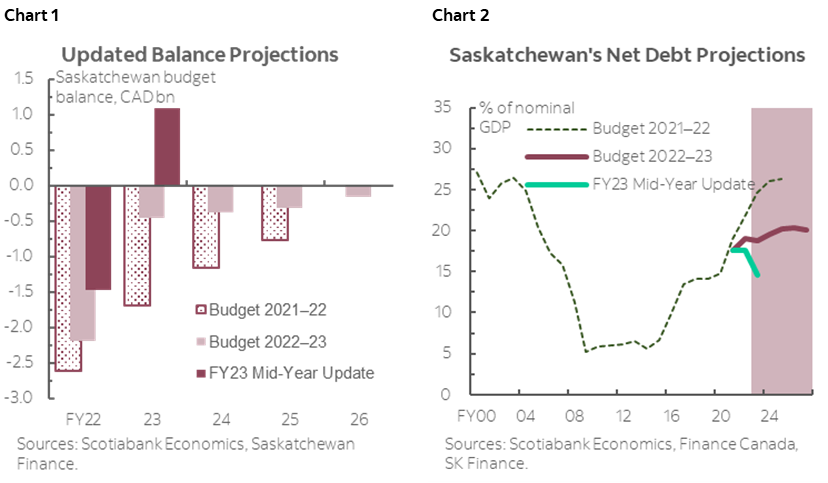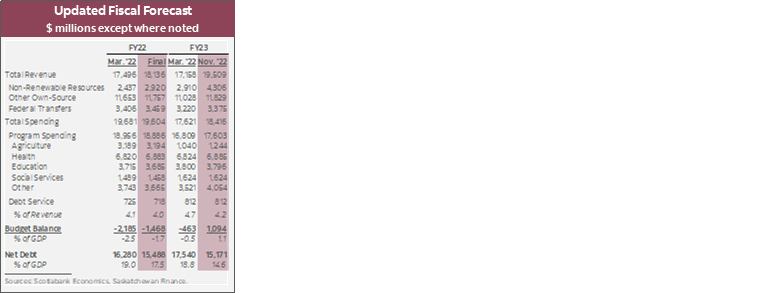A MUCH-ANTICIPATED BUDGET TURNAROUND BACKS FISCAL RELIEF
- Budget balance forecasts: $1.1 bn (1.1% of nominal GDP) in FY23, a turnaround from the -$463 mn (-0.5%) deficit projected in Budget 2022 (chart 1), while the FY22 shortfall came in more than $700 mn less than budgeted.
- Net debt: lowered by $2.4 bn versus Budget to $15.2 bn for FY23 (chart 2); as a share of nominal output, net debt is now expected to decline from 17.5% in FY22 to 14.6% in FY23.
- Real GDP growth forecast: increased from 3.7% to 4.7% for 2022 but nudged down from 2.5% to 1.4% for 2023; nominal GDP projection raised from 9.0% to 17.5% for 2022 but reduced from 3.7% to 1.1% for 2023.
- WTI price projections lifted to US$91.0/bbl in FY23 from US$75.75/bbl projected in Budget 2022.
- The improvements in the province’s bottom line seem reasonable with economic assumptions on the conservative side. Although the surplus this year does not guarantee improvements over the longer term as deteriorating economic outlook weighs on revenues and adds to spending pressure, Saskatchewan’s strengthened fiscal position gives the province plenty of advantage over its peers in weathering the upcoming downturn.

OUR TAKE
As widely anticipated, Saskatchewan is on track to achieve a hefty surplus of $1.1 bn (1.1% of nominal GDP) in FY23 instead of the -$463 mn (-0.5%) deficit projected in Budget 2022—a fast turnaround from the deep shortfall of -$1.5 bn posted last fiscal year. With the bulk of the surplus designated for debt repayment, the net debt-to-GDP ratio projection fell to 14.6%, the second lowest among the provinces that have released mid-year updates, exceeding only that of Alberta.
Revenues are expected to come in $2.4 bn (13.7%) stronger than projected in March with increases anticipated in all categories. Although non-renewable resource revenues drove the upward revision versus the Budget ($1.4 bn, 48%) on the back of higher oil and potash prices, it was revised down by -$462 mn since the first quarter update due to the slight softening in commodity price outlook. WTI prices are now expected to average US$91.0/bbl in FY23, slightly below levels suggested by the forward curve (around US$93.0/bbl). Potash price assumption is US$571/KCI tonne, up US$164/KCI tonne from Budget. Forecast for other own-source revenues was lifted by $801 mn (7.3%) as nominal GDP projection jumped from 9.0% to 17.5% for 2022—still conservative compared to our latest forecast of 20% nominal growth. The prudence built into this update should provide some offset to potential downside risks in commodity prices stemmed from a slowing global growth and geopolitical developments.
Program spending forecast was lifted by $794 mn (4.7%) versus the Budget due to Affordability measures and increases in agriculture spending. The Update incorporates the one-time Saskatchewan Affordability Tax Credit (SATC) payments announced in August. The broad-based measure offers sizable relief with an estimated cost of $450 mn (0.4% of nominal GDP) in the near term, but the fiscal impact should wane quickly. Agriculture spending also adds to higher expenses with $204.3 mn increases in Saskatchewan Crop Insurance indemnities as a result of the lingering impact of last year’s drought.
Borrowing projections were not updated, but with close to $1.6 bn improvement in the budget balance, the program will be much lower than the $3.5 bn forecast for FY23 at Budget time.

DISCLAIMER
This report has been prepared by Scotiabank Economics as a resource for the clients of Scotiabank. Opinions, estimates and projections contained herein are our own as of the date hereof and are subject to change without notice. The information and opinions contained herein have been compiled or arrived at from sources believed reliable but no representation or warranty, express or implied, is made as to their accuracy or completeness. Neither Scotiabank nor any of its officers, directors, partners, employees or affiliates accepts any liability whatsoever for any direct or consequential loss arising from any use of this report or its contents.
These reports are provided to you for informational purposes only. This report is not, and is not constructed as, an offer to sell or solicitation of any offer to buy any financial instrument, nor shall this report be construed as an opinion as to whether you should enter into any swap or trading strategy involving a swap or any other transaction. The information contained in this report is not intended to be, and does not constitute, a recommendation of a swap or trading strategy involving a swap within the meaning of U.S. Commodity Futures Trading Commission Regulation 23.434 and Appendix A thereto. This material is not intended to be individually tailored to your needs or characteristics and should not be viewed as a “call to action” or suggestion that you enter into a swap or trading strategy involving a swap or any other transaction. Scotiabank may engage in transactions in a manner inconsistent with the views discussed this report and may have positions, or be in the process of acquiring or disposing of positions, referred to in this report.
Scotiabank, its affiliates and any of their respective officers, directors and employees may from time to time take positions in currencies, act as managers, co-managers or underwriters of a public offering or act as principals or agents, deal in, own or act as market makers or advisors, brokers or commercial and/or investment bankers in relation to securities or related derivatives. As a result of these actions, Scotiabank may receive remuneration. All Scotiabank products and services are subject to the terms of applicable agreements and local regulations. Officers, directors and employees of Scotiabank and its affiliates may serve as directors of corporations.
Any securities discussed in this report may not be suitable for all investors. Scotiabank recommends that investors independently evaluate any issuer and security discussed in this report, and consult with any advisors they deem necessary prior to making any investment.
This report and all information, opinions and conclusions contained in it are protected by copyright. This information may not be reproduced without the prior express written consent of Scotiabank.
™ Trademark of The Bank of Nova Scotia. Used under license, where applicable.
Scotiabank, together with “Global Banking and Markets”, is a marketing name for the global corporate and investment banking and capital markets businesses of The Bank of Nova Scotia and certain of its affiliates in the countries where they operate, including; Scotiabank Europe plc; Scotiabank (Ireland) Designated Activity Company; Scotiabank Inverlat S.A., Institución de Banca Múltiple, Grupo Financiero Scotiabank Inverlat, Scotia Inverlat Casa de Bolsa, S.A. de C.V., Grupo Financiero Scotiabank Inverlat, Scotia Inverlat Derivados S.A. de C.V. – all members of the Scotiabank group and authorized users of the Scotiabank mark. The Bank of Nova Scotia is incorporated in Canada with limited liability and is authorised and regulated by the Office of the Superintendent of Financial Institutions Canada. The Bank of Nova Scotia is authorized by the UK Prudential Regulation Authority and is subject to regulation by the UK Financial Conduct Authority and limited regulation by the UK Prudential Regulation Authority. Details about the extent of The Bank of Nova Scotia's regulation by the UK Prudential Regulation Authority are available from us on request. Scotiabank Europe plc is authorized by the UK Prudential Regulation Authority and regulated by the UK Financial Conduct Authority and the UK Prudential Regulation Authority.
Scotiabank Inverlat, S.A., Scotia Inverlat Casa de Bolsa, S.A. de C.V, Grupo Financiero Scotiabank Inverlat, and Scotia Inverlat Derivados, S.A. de C.V., are each authorized and regulated by the Mexican financial authorities.
Not all products and services are offered in all jurisdictions. Services described are available in jurisdictions where permitted by law.

